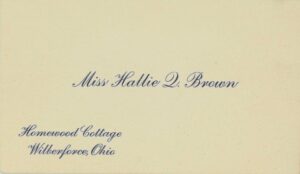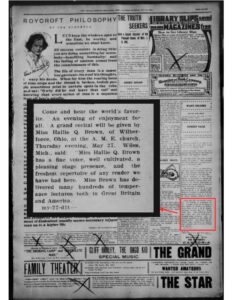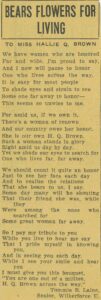Special thanks to our guest contributor Kevin Lydy at the National Afro-American Museum & Cultural Center (NAAMCC) for writing this blog.
So I pay my tribute to you
While you live to hear me say
That I pride myself in knowing you,
And in seeing you each day.
While I see your smile and hear you
I must give you this bouquet,
“You are one out of a million,
Q. Brown across the way.”
- Tommie B. Laine
Senior, Wilberforce U.

Hallie Quinn Brown's business card.
Imagine being so well-known, so respected, so famous, that your business card only needed your name and address. The mere mention of your name would be enough to allow those in possession of your business card to marvel and stand in awe. Now imagine, over 100 years later, that same business card has the opposite effect, causing those in possession of it to simply wonder who this person is or what they did. Enter Hallie Quinn Brown—one of the most famous women of her time but who many today, unfortunately, know so little about. The Hallie Quinn Brown Collection in the Archives of the National Afro-American Museum and Cultural Center in Wilberforce contains a treasure trove of resources that not only shed light onto this amazing woman, but also provides an opportunity for students to engage with their own history in ways that address many of the ODEW’s Content Standards for the Social Studies.

The Daily Journal- Herald, May 22nd, 1909. The inset image promotes a Hallie Quinn Brown speaking engagement at A.M.E. Church in Wilberforce, Ohio.
Students can truly do the work of historians by examining one of the most debated facts about Hallie Quinn Brown: her birthdate. Depending on the biographical source, Brown was either born in 1845 or 1850. After holding a brief discussion about the reasons why they believe this discrepancy could exist, students can delve into an examination of the credibility of sources.

"Bears Flowers for Living," a poem dedicated to Hallie Quinn Brown by senior Wilberforce University student Tommie B. Laine.
Brown was most famous during her time for being an elocutionist, delivering performances and recitations to audiences numbering in the tens of thousands. Utilizing newspapers from Ohio Memory, such as The Daily Journal-Herald, students can create updated business cards that showcase Brown’s various occupations (lecturer, author, teacher, performer, etc.). The newspapers can also be compared to newspapers from today, allowing students to understand how primary sources can be used to show how local communities change over time.
Brown was also an internationally renowned suffragist and civil rights activist. She served as the President of the National Federation of Colored Women and traveled around the world addressing society’s ills. She navigated the precariousness of the Victorian era, with its heavily restricted spheres of influence for women, by championing Temperance and eventually women’s suffrage as well as equal rights for African Americans. Placing Brown’s efforts within classroom lessons that focus on Frederick Douglass and Elizabeth Cady Stanton can help students not only see that local history runs concurrent with national history, but that African American women played a pivotal role in the quest for equality and justice.
The Education Specialist at the National Afro-American Museum and Cultural Center has created K-12 lesson plans that incorporate many of the resources mentioned in this Resource Roundup, and many more. Please contact Mr. Kevin Lydy at [email protected] or call 800-752-2603 ext. 0 for more information on incorporating Hallie Quinn Brown into your classroom.